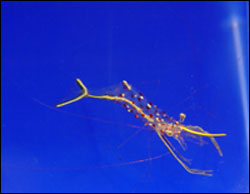Cleaner shrimp use rocking dance to advertise their service to clients

Photo Credit: Justine Becker Full size images available through contact.
Using underwater field observations in conjunction with behavioral experiments, researchers have discovered that a small crustacean, the yellow-beaked cleaner shrimp, performs a specialized dance that affects the behavior of large, predatory client fish. This signaling represents shrimp-to-fish communication that allows both hungry cleaner shrimp and parasite-laden client fish to benefit from a non-predatory, “cleaning” interaction.
The cleaner-client relationship between the shrimp and the fish fulfills many criteria of an economic market, and in this context the shrimp’s signals essentially represent “advertising.” The work is reported by Justine Becker and colleagues at the University of Queensland.
When unrelated animals cooperate, signals may be used by individuals to avoid potential conflicts. For example, during animal cleaning interactions, which involve a cleaner that removes parasites and other material from the body surfaces of cooperating individuals (known as clients), conflict may arise over the timing and duration of an interaction, over what the cleaner should feed on, or even over the temptation of some clients to eat the cleaner. Marine cleaning interactions are well known for highly stereotyped behaviors that most likely serve as signals.
For example, tactile dancing behavior used by cleaner fish enables them to avoid conflict with potentially dangerous clients. Cleaner shrimp also clean fish, yet they live in small caves and crevices on the reef and are not immediately visible to client fish. Signals, therefore, are likely to be essential for cleaner shrimp to attract potential clients.
In work now reported, Justine Becker and colleagues conducted field observations that revealed that the yellow-beaked cleaner shrimp uses a stereotypical side-to-side movement, or “rocking dance,” when approaching potential client fish in the water column and that this dance is followed 100% of the time by a cleaning interaction with a client. They then manipulated the hunger levels of these cleaners to show that hungry cleaner shrimp, which are more willing to clean than satiated ones, spend more time rocking and in closer proximity to client fish than do satiated cleaner shrimp. In addition, hungry cleaner shrimp were approached more often by client fish than were satiated cleaner shrimp.
With these observations, Becker and colleagues were able to show that the rocking dance used by the yellow-beaked cleaner shrimp influenced the behavior of client fish and that this dance appears to function as a signal to advertise the presence of cleaner shrimp to potential clients.
Media Contact
All latest news from the category: Life Sciences and Chemistry
Articles and reports from the Life Sciences and chemistry area deal with applied and basic research into modern biology, chemistry and human medicine.
Valuable information can be found on a range of life sciences fields including bacteriology, biochemistry, bionics, bioinformatics, biophysics, biotechnology, genetics, geobotany, human biology, marine biology, microbiology, molecular biology, cellular biology, zoology, bioinorganic chemistry, microchemistry and environmental chemistry.
Newest articles

A universal framework for spatial biology
SpatialData is a freely accessible tool to unify and integrate data from different omics technologies accounting for spatial information, which can provide holistic insights into health and disease. Biological processes…

How complex biological processes arise
A $20 million grant from the U.S. National Science Foundation (NSF) will support the establishment and operation of the National Synthesis Center for Emergence in the Molecular and Cellular Sciences (NCEMS) at…

Airborne single-photon lidar system achieves high-resolution 3D imaging
Compact, low-power system opens doors for photon-efficient drone and satellite-based environmental monitoring and mapping. Researchers have developed a compact and lightweight single-photon airborne lidar system that can acquire high-resolution 3D…





















